In the Premier League game week 29, Tottenham travelled to Turf Moor to challenge Burnley. José Mourinho’s team were knocked out by Norwich in the FA Cup in their midweek fixture and so they were looking to bounce back and continue their fight to reach the Champions League qualification spot.
Burnley were the better side in this game; their xG total of 3.57 was more than a triple of Tottenham’s 1.06. Before a quarter of an hour had passed, Sean Dyche’s team had scored first through Chris Wood’s goal. In the second half, Mourinho made some tactical changes and Dele Alli equalized from a spot-kick.
In this tactical analysis, we will show you how Burnley drew against Tottenham at home. It is an analysis that focuses on tactics.
Lineups
Dyche’s team played in a 4-4-2. The starting eleven was similar to the last game, and the only change was playing Chris Wood with Jay Rodriguez instead of Matěj Vydra. Dwight McNeil played as the left-winger, he had a pretty good game along with the left-back, Charlie Taylor.
Mourinho rotated his squad after the 120-minute clash in midweek and the Portuguese also switched the formation to a 3-4-3. Toby Alderweireld joined Eric Dier and Davinson Sánchez as a back three. Japhet Tanganga started as the right wing-back. Tanguy Ndombélé started with the youngster Oliver Skipp at the midfield. Erik Lamela replaced Lucas Moura as the right-winger and Alli continued to play as a striker.
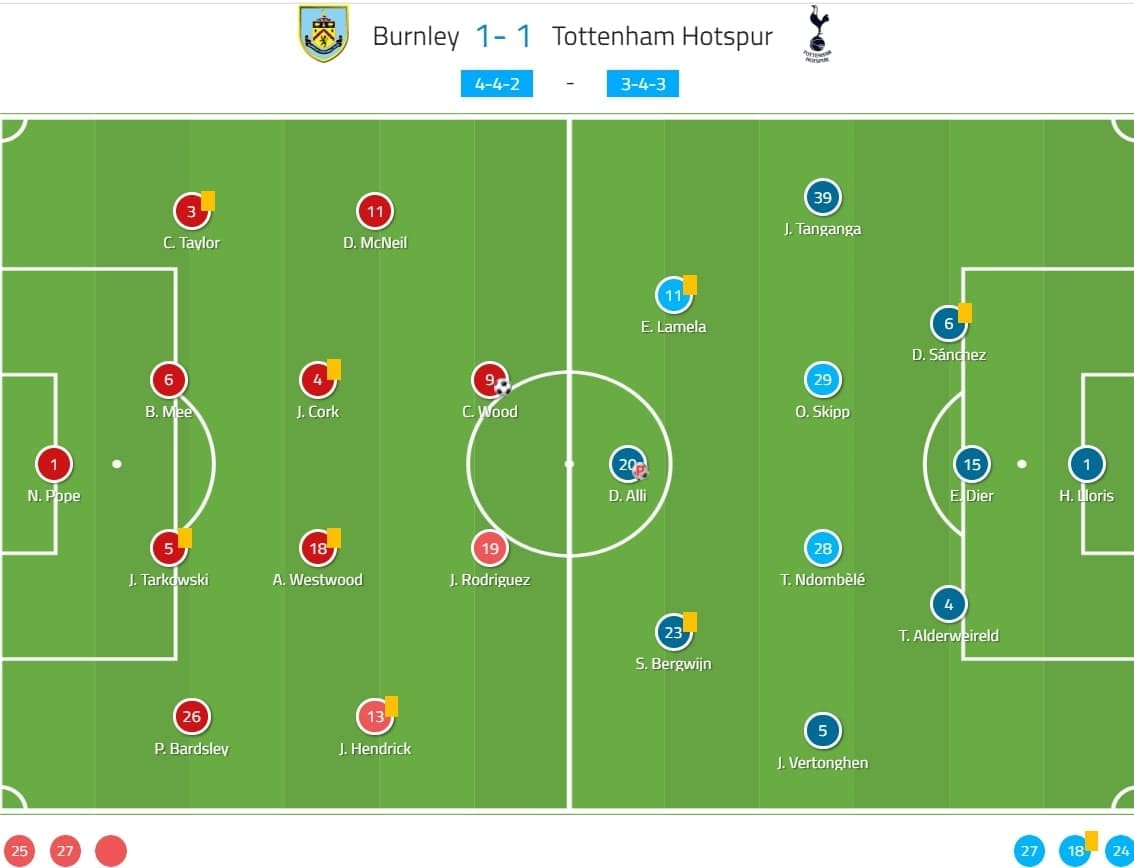
Tottenham’s offensive inefficacy
First, we want to illustrate Tottenham’s first phase of their attack. For the away team, their xG in the first half was merely 0.06 from two shots, despite enjoying 51% of possession. Their attacks were ineffective and inefficient due to a series of issues.
Everyone knows how Mourinho’s team was going to set their build-up positionings. It would be a back three with a pair of pivots, regardless of the formation. Then, they had both wide players pushing high to provide the width, who, in this game, were the wing-backs. These are highlighted in the following image.
When moving the ball, both pivots (Ndombélé and Skipp) showed limited inclination to provide support. They were behind the Burnley strikers on most occasions, hence, the centre-backs became the major source to provide the out ball. However, Tottenham’s offensive players stayed too high and so the options for a short pass were limited. If they passed to the dropping wing-backs, the receivers were forced to receive the ball in a closed body orientation due to the pressure at their back. This was the case with Jan Vertonghen in this image.
On other occasions, Tottenham played long balls to attempt to penetrate through the wide areas of Burnley, where the opposition full-backs could not cover. However, they could hardly develop meaningful chances given their physical disadvantages.
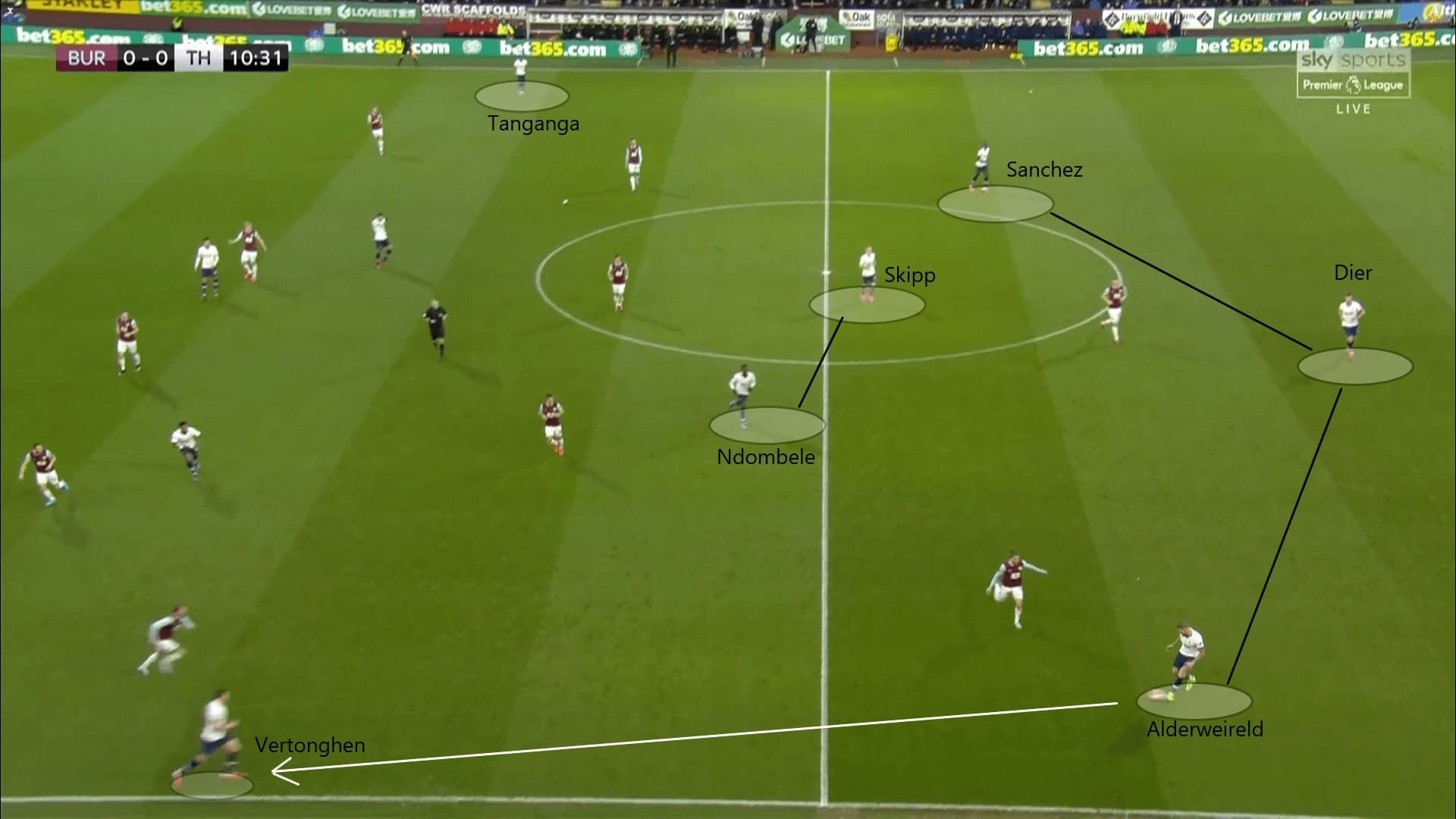
In the attacking third, Tottenham players lacked connection. As you can see in this image, Steven Bergwijn was isolated against two players. From his teammates, Vertonghen was reluctant to provide an overlapping run since the asymmetrical attack of Tottenham only allowed one wing-back to push high. In this scenario, Tanganga stayed high so the Belgian stayed slightly deeper. In case of Alli and Lamela, it was conceivable that they were staying in the centre to look for a cross. Ndombélé, meanwhile, did not show the willingness to help his teammates, merely positioning himself in the centre, within the Burnley players. It was almost impossible for Bergwijn to pass to him.
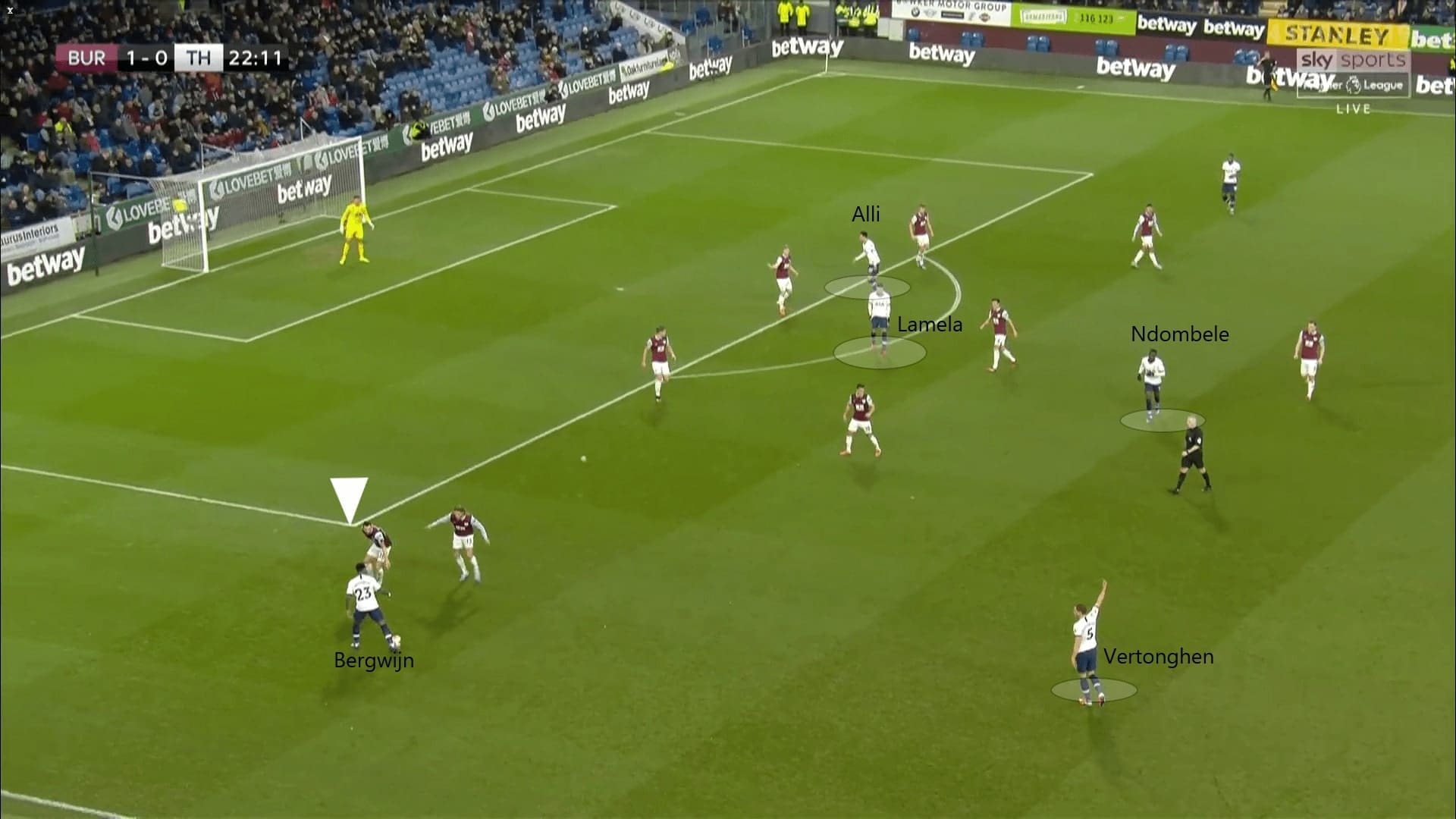
Burnley well-organized defence
Of course, Burnley did a tremendous job to defend and they disturbed Tottenham’s attacks. Despite defending in a 4-4-2, they pushed the defensive block high to deny the build-up. When pressing, you can interpret the shape as a 4-3-3 as McNeil would leave the midfield line to approach the right centre-back (Sánchez). The midfield line would take care of the players between the lines then. Given the limited ability of the Colombian to penetrate the block, Tottenham played long to eliminate the pressure, which was not a problem for Burnley to deal with.
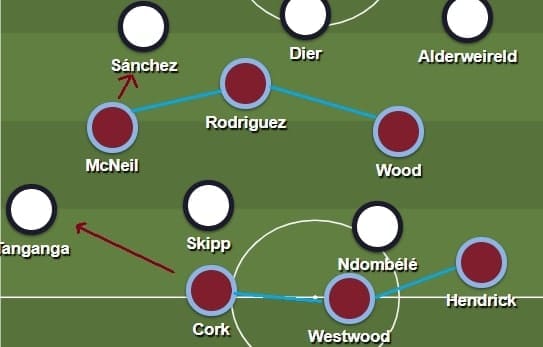
On most occasions, the highest striker of Burnley would signal to press. In this scenario, Rodriguez summoned McNeil to join the press. The 20-year-old prevented a short pass to Tanganga initially. Dier tried to play long to eliminate the press but the execution was not right.
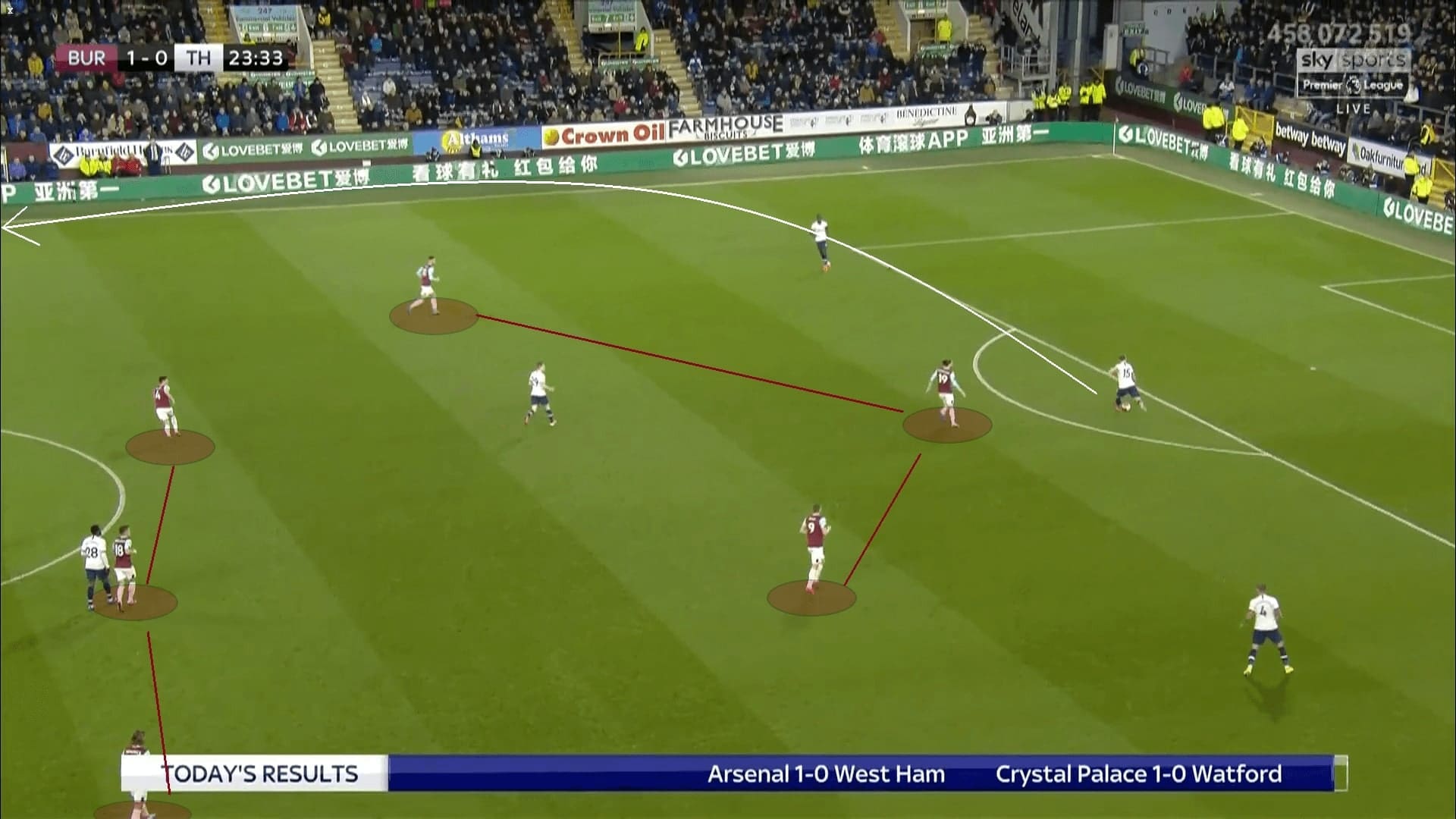
The defensive approach of Burnley also won them the numerical superiority on the flanks. The hard work of the strikers should be credited as they were tasked to cover the pivots when Tottenham were progressing the ball. In such cases, Burnley’s left-winger (McNeil) could close the right wing-back (Tanganga), allowing the midfield line of Burnley to stay deeper and reduce spaces between the lines.
The idea was illustrated in this image. Basically, Jack Cork and Taylor could take care of Lamela since McNeil and Rodriguez already marked Skipp and Tanganga. It was a 5 v 4 numerical superiority. Even though Alli could appear in that zone, the Clarets also had Ben Mee to approach the striker.
In such cases, Tottenham should have moved the ball away from the strong side and reorganized the attack, but they lacked composure and patience to do this.
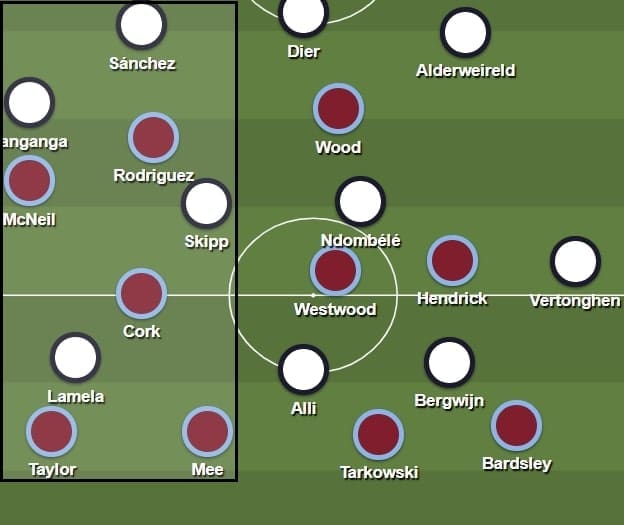
Below is a game scenario. When Burnley allowed Tottenham’s centre-backs to carry the ball forward, it was usually Sánchez since the Colombian was uncomfortable on the ball.
In those cases, the strikers had to try to eliminate the Tottenham pivots by covering the passing lanes. You can see Rodriguez shut the passing lane to Skipp instead of pressing Sánchez in this image. As explained, this spared the central midfielder to defend deeper, and so Cork could approach Alli.
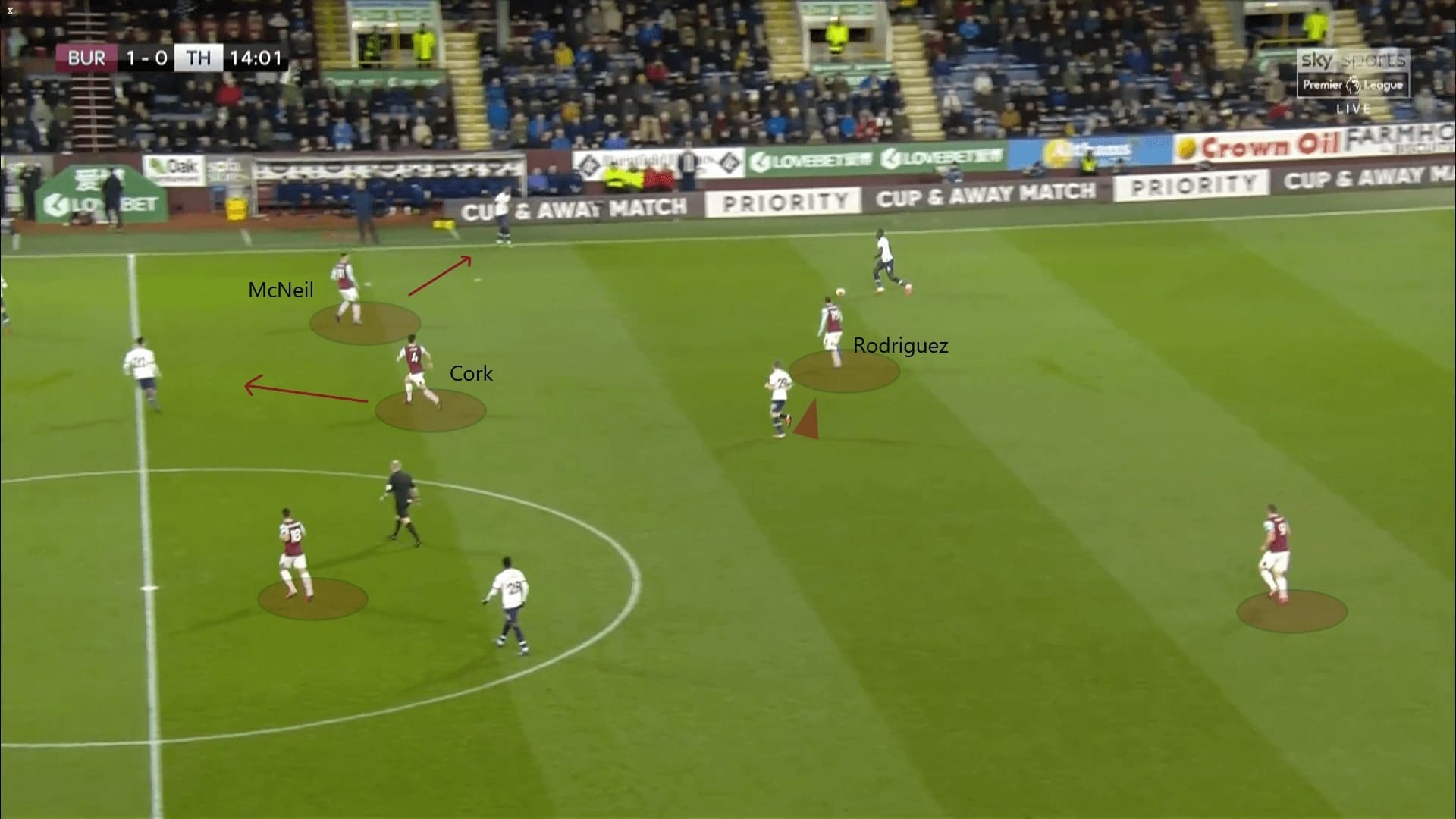
The defence of Burnley was quite impressive in this game as the defenders were keen to step out early, pressing the ball receiver to deny the development of the attack. Therefore, the central overload of Tottenham did not work. Space behind the defenders was not a major concern as no one exploited those areas once Alli left the frontline.
In this scenario, you can see Tottenham had four players in the midfield, this could potentially overload Cork and Ashley Westwood. It was still a 3 v 4 numerical deficit even if Jeff Hendrick was positioned at the centre.
The disciplinary of the Burnley players was incredible. In this case, you can see Rodriguez was approaching from Ndombélé’s back while James Tarkowski followed Alli tightly. This turned from a deficit to a numerical superiority of 5 v 4 thanks to these two players. Furthermore, Alli could not deal with the pressure from his blindside and Burnley recovered the ball.
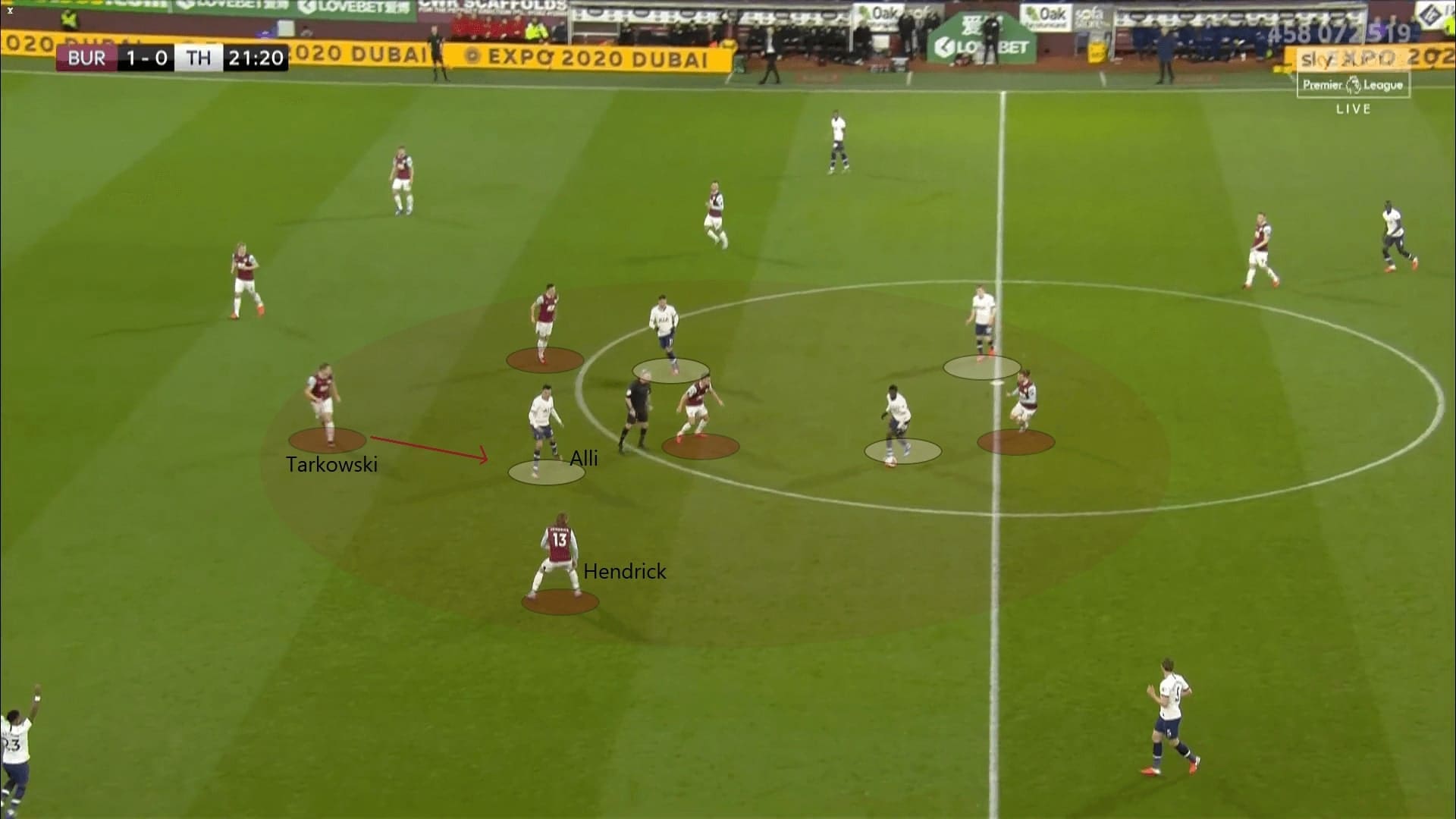
When defending deeper, Burnley made an effort to protect the half-spaces. It mostly happened in the second half when they did not press the opposition. In those cases, the wingers stayed very deep to cover the wide areas for the full-backs; as you can see, Hendrick was in line with the defenders. Therefore, Phil Bardsley could stay compact to protect the half-spaces. The same theory worked on McNeil’s and Taylor’s left side as well.
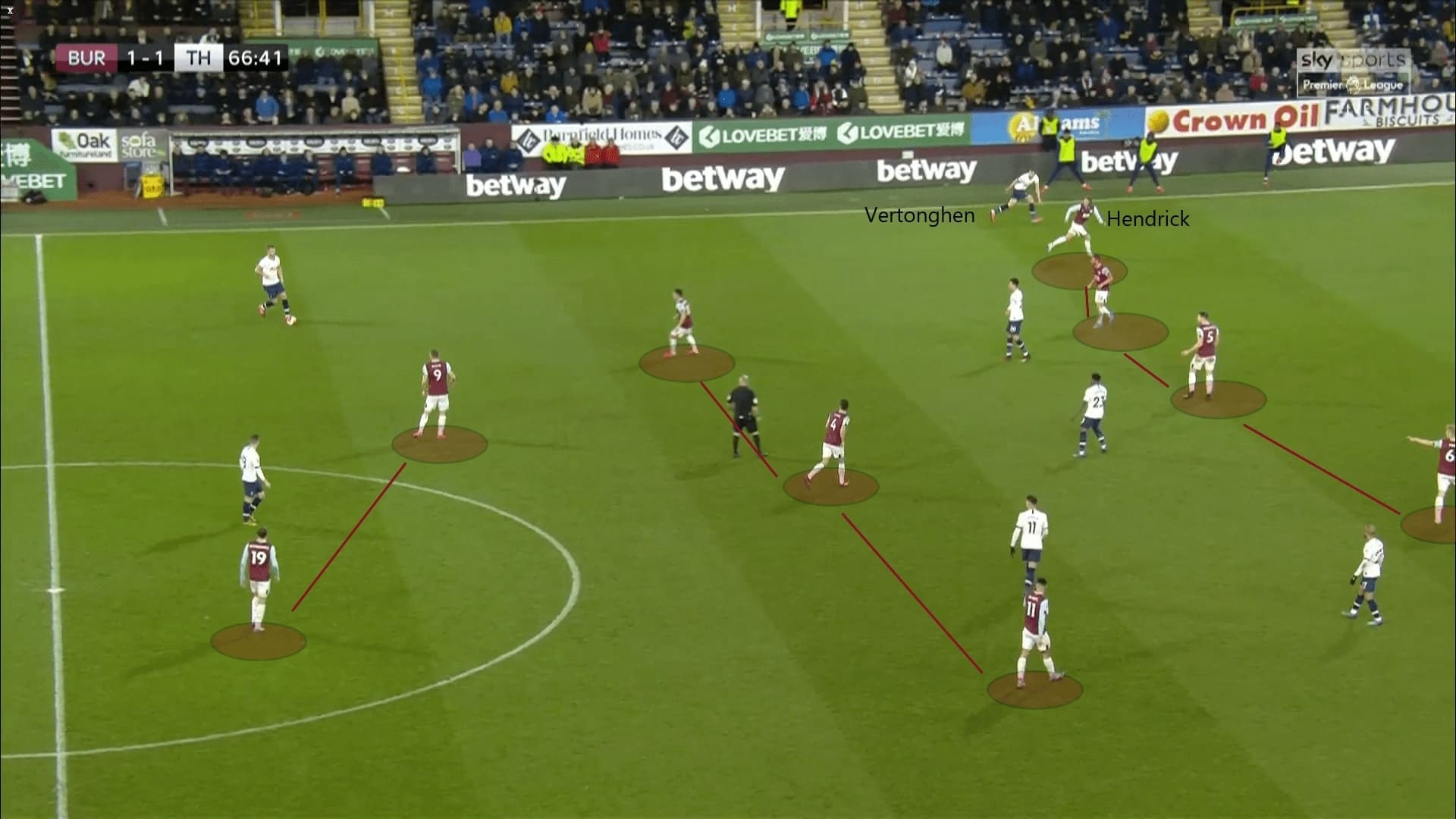
Burnley’s offensive style of play
Offensively, Burnley also did quite well in this game. They had strikers with physical superiority, and so to maximize their strengths, they needed crosses. The Clarets committed their players to attack and utilized the width of the pitch to stretch the Spurs defence.
A key component of Burnley’s attack was McNeil and Taylor on the left flank. These two players consistently provided the attacking threat with overlapping runs and crosses. Of Burnley’s 24 crosses, 18 of them came from these two players (McNeil: 10; Taylor: eight). Moreover, 23 crosses occurred from the left flank.
Since Taylor had the energy to provide the forward runs, he became the widest player on the left, allowing McNeil to stay in the half-spaces. Without the protection of a winger, Tanganga was overloaded by two players and he could not take care of both. It was an easy job for McNeil to release Taylor in this situation.
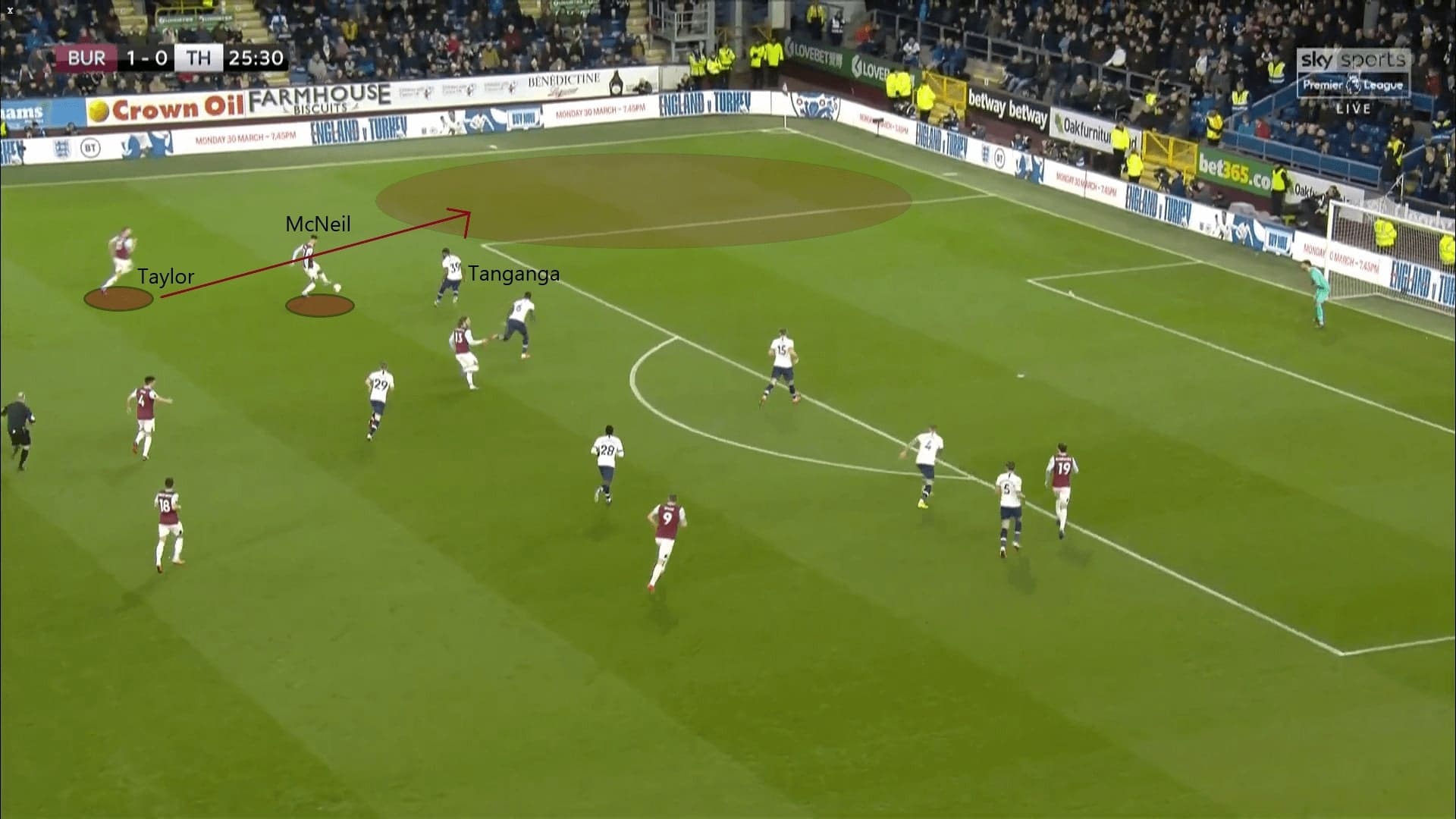
This example demonstrates how Burnley utilized the width. When playing long, Dyche did not mind the forward players staying wide. You can see Wood and Rodriguez were far from each other on both sides. McNeil was supporting the former Southampton striker in this case.
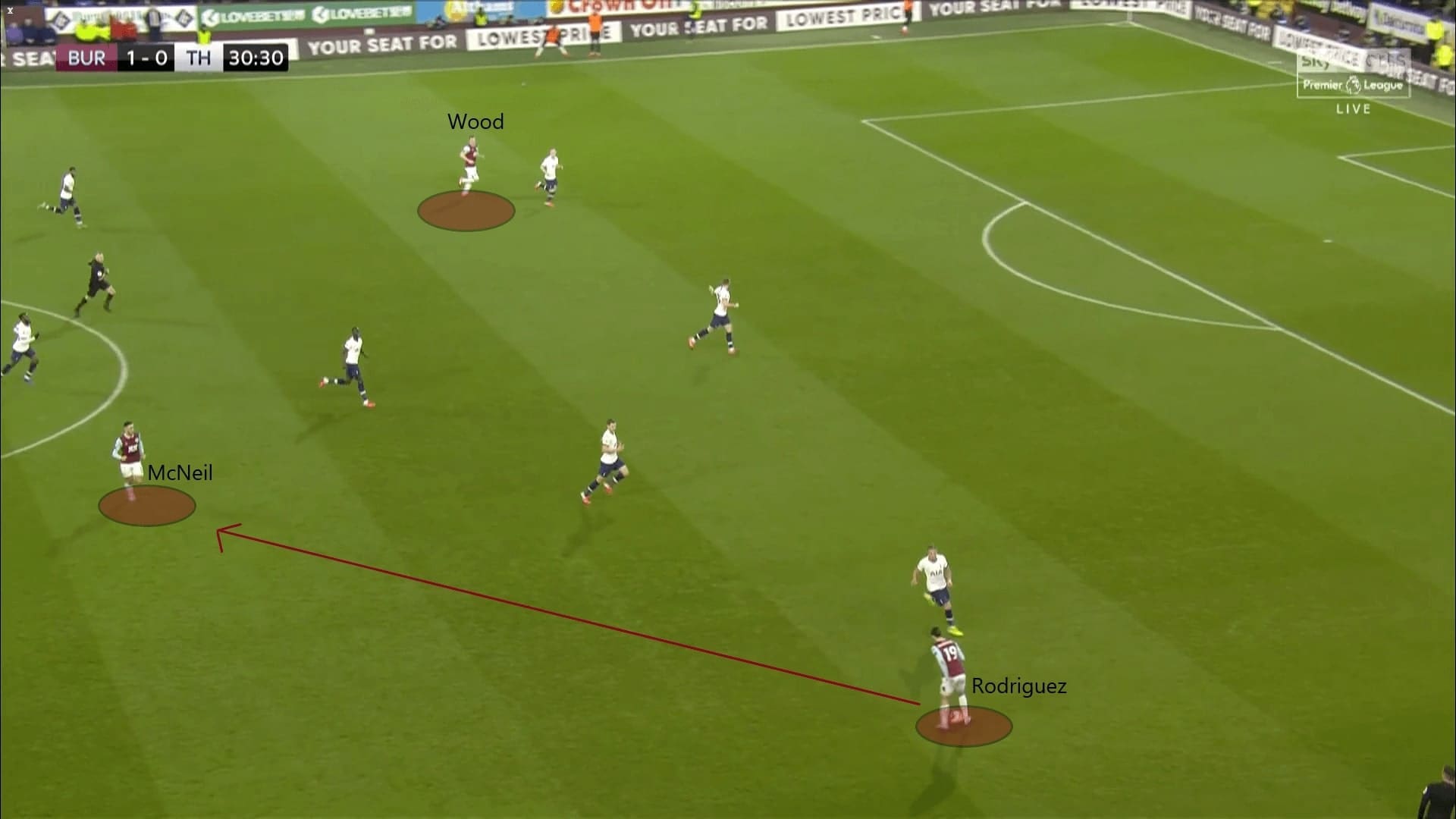
Five seconds later, when McNeil turned, Burnley were attacking in a good shape. With the support from the offensive let-back Taylor and the midfielders, the Clarets successfully occupied four vertical zones on the pitch. McNeil had a lot of options and he picked Taylor on the left flank to develop the attack.
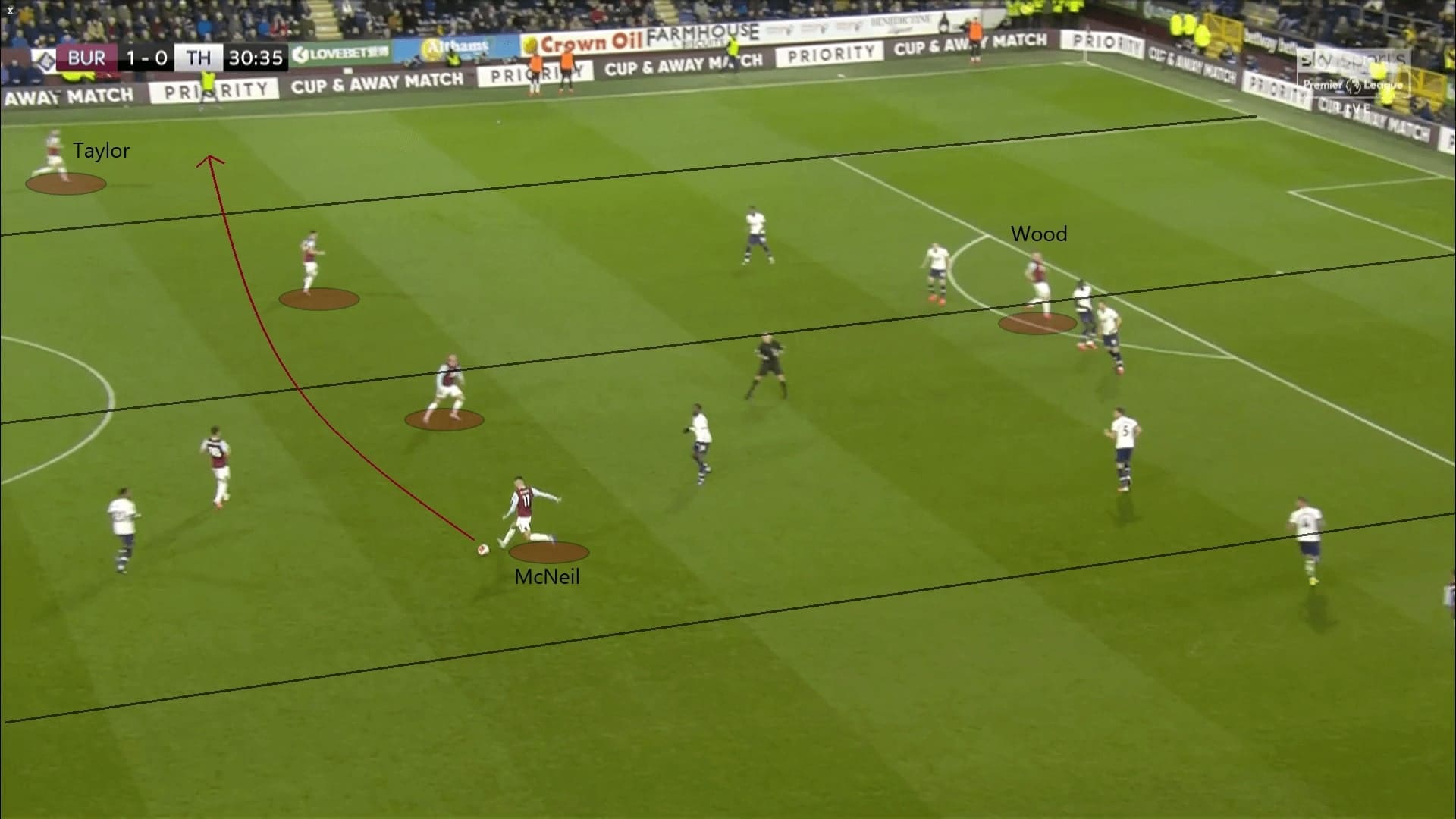
Vydra replaced Rodriguez in the 68th minute. The Czech received some instructions and provided a fresh pair of legs in the attack. In the latter stages of the game, Burnley tried to exploit the gap between Tanganga and Sánchez. This was a smart move as these two players were weaker than the Belgians on the other side.
Burnley utilized the two-striker system, by positioning one of them in the left half-spaces, while the other striker had the freedom to run forward. As shown in this image, Vydra’s forward run created room for Wood to receive the ball.
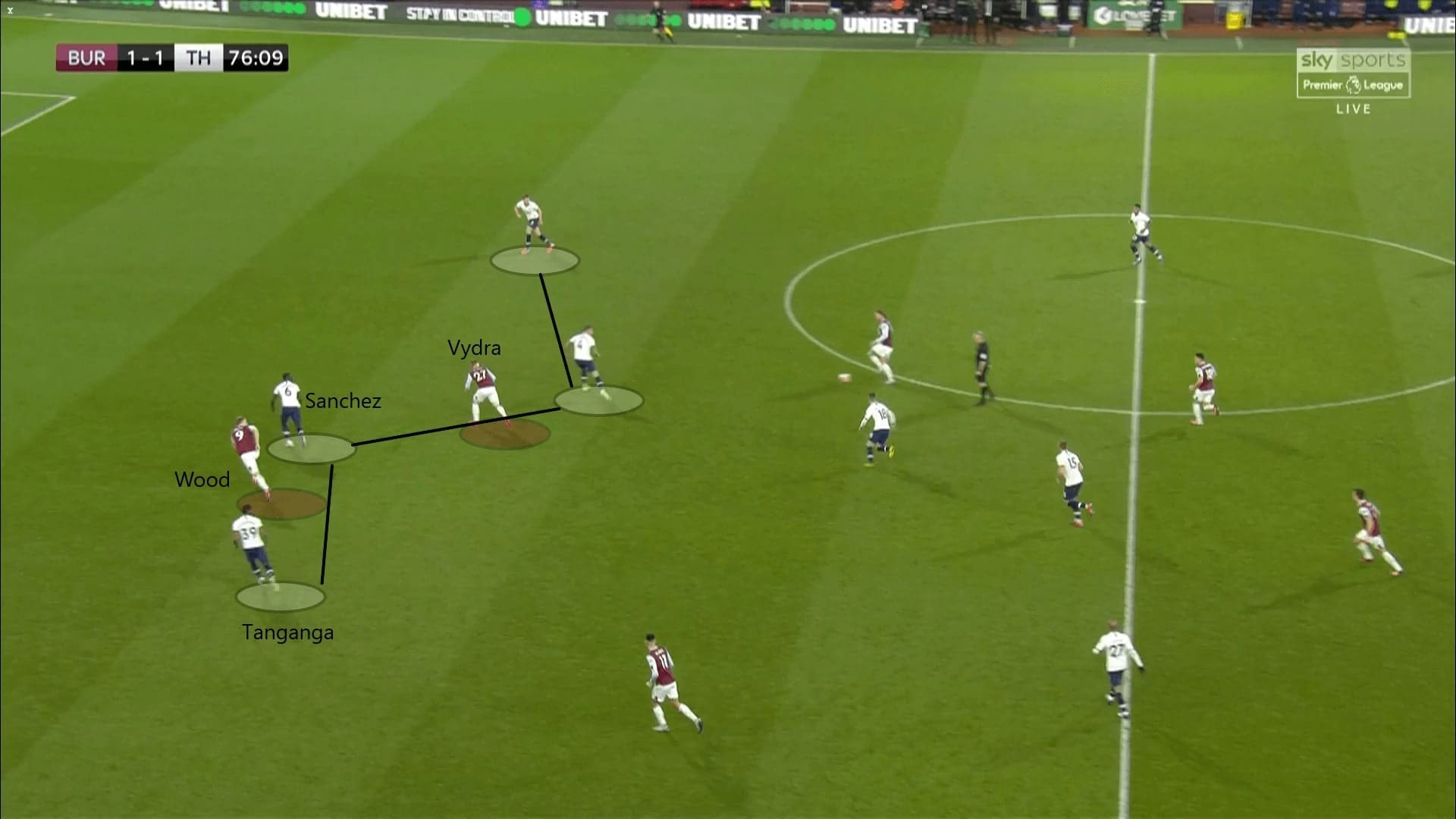
Defensive issues of Tottenham
For Tottenham, their defence was not good enough. There were some issues which remained unsolved and allowed Burnley to develop the attack easily. The first we would like to point out was the pressing issue. Mourinho’s men tried to defend in a 5-4-1 but ironically, his key coaching philosophy, compactness was an issue.
The major problem was twofold. First, it was the positioning of the midfielders; they were spread out too flat on the pitch. Although this allowed the Lilywhites to cover a larger area in the central third, this also left huge horizontal gaps between the midfielders. You can see in this image, the distance between the midfielders was large.
The second problem was the vertical compactness. For the defenders, especially the wing-backs, they were under an awkward circumstance. Usually, Mourinho would like his wing-backs to stay deep and compact with the centre-backs, but this was confusing when the opposition dropped. As you can see in this case, the left-winger (McNeil) left his position and dropped deep. Initially, Tottenham’s pivots had two players to protect the central areas. When Skipp noticed McNeil’s presence, he tried to approach the 20-year-old and called for support, as you can see in this image. He had to make sure Cork was under control before stepping out. However, Tanganga was too far away from Skipp and he hesitated, resulting in a failed press.
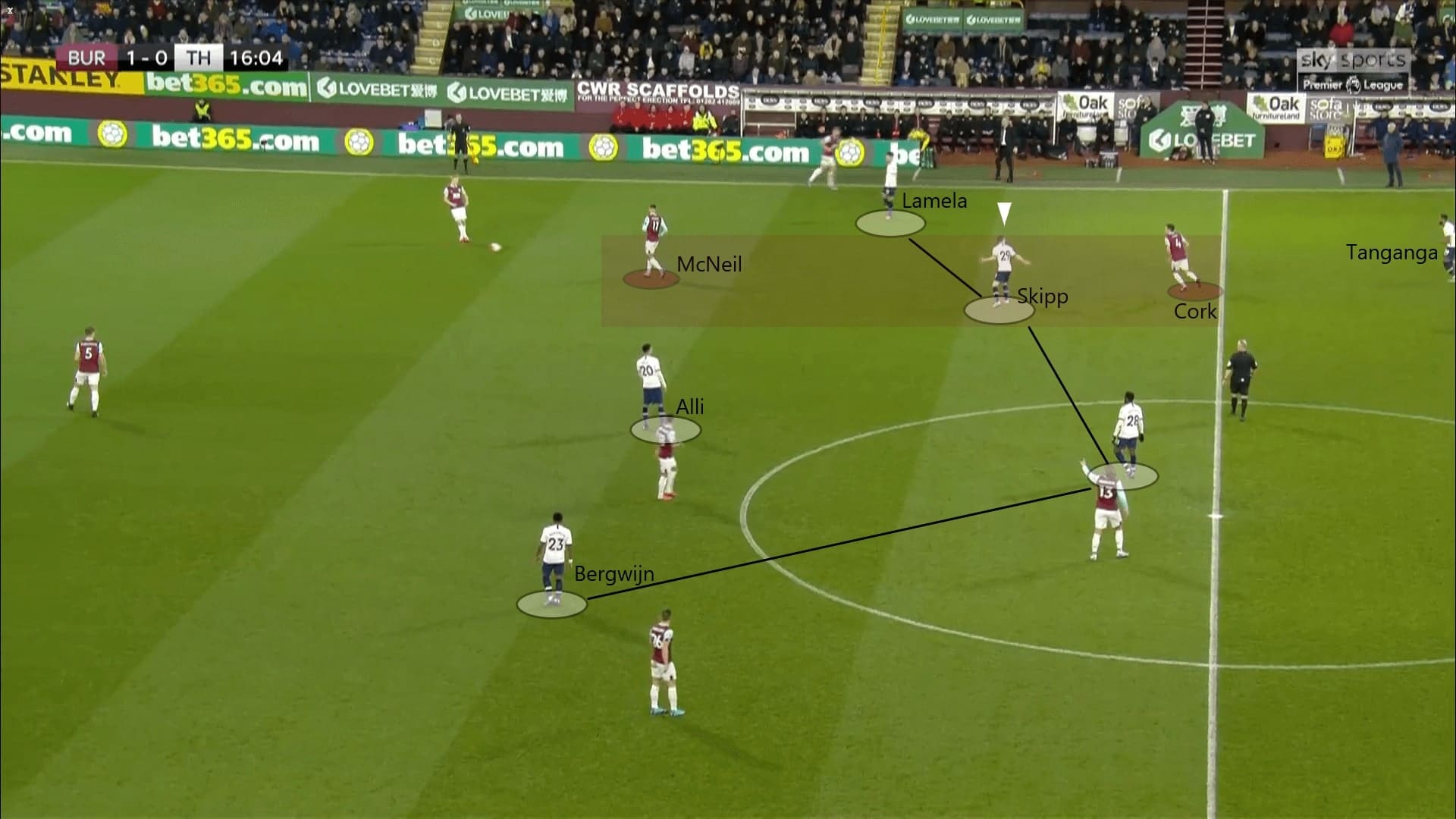
In the first half, Burnley had more chances to develop their attack. Spaces behind Tanganga became a targeted area to attack. As explained in the above section, Burnley tended to attack the left, and Tanganga was overloaded.
However, if Tanganga stepped out, then Burnley attacked spaces behind him. In this scenario, McNeil carried the ball forward and took Tanganga out. However, Sánchez did not follow, and this gave Taylor the chance to exploit the highlighted area.
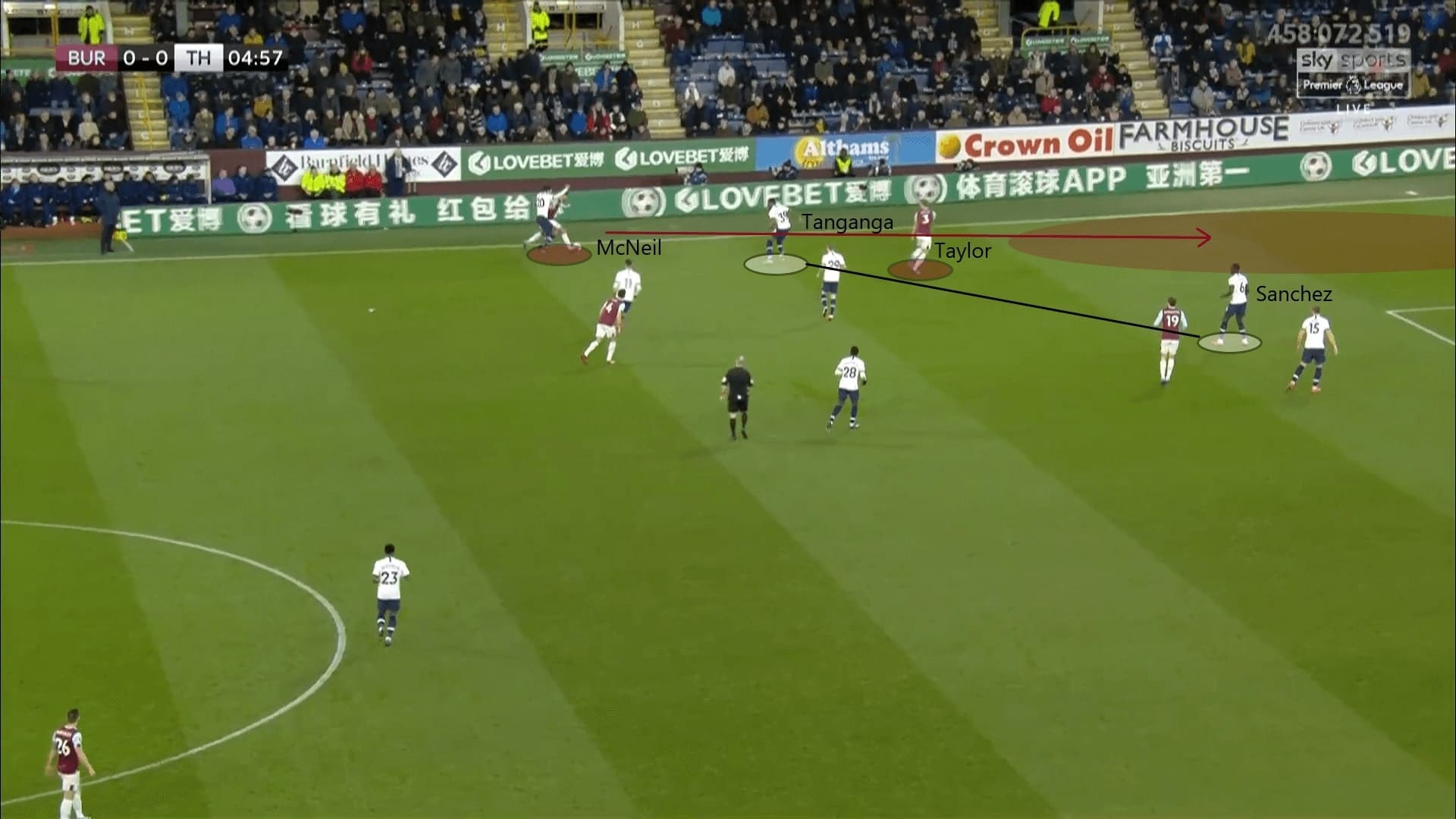
Control of the second balls
Another point to note was the poor recovery of second balls of Tottenham in this game. It was conceivable that picking the second balls was a difficult task at Turf Moor as most teams cannot match the physicality of the Burnley players. However, it was both a structural issue and a motivation issue in this game.
When defending the cross, the Lilywhites defenders retreated to the six-yard box and the pivots also stayed in the box. Of course, this approach allowed Tottenham to defend with numbers in the penalty box. However, without the protection of the offensive players, zone 14 of Burnley was totally empty.
In this example, we saw both Skipp and Ndombélé approaching Wood in their own box. As a result, Westwood was totally free in zone 14. The Lilywhites could not win the ball from Wood and this became a dangerous shooting opportunity for the Clarets.
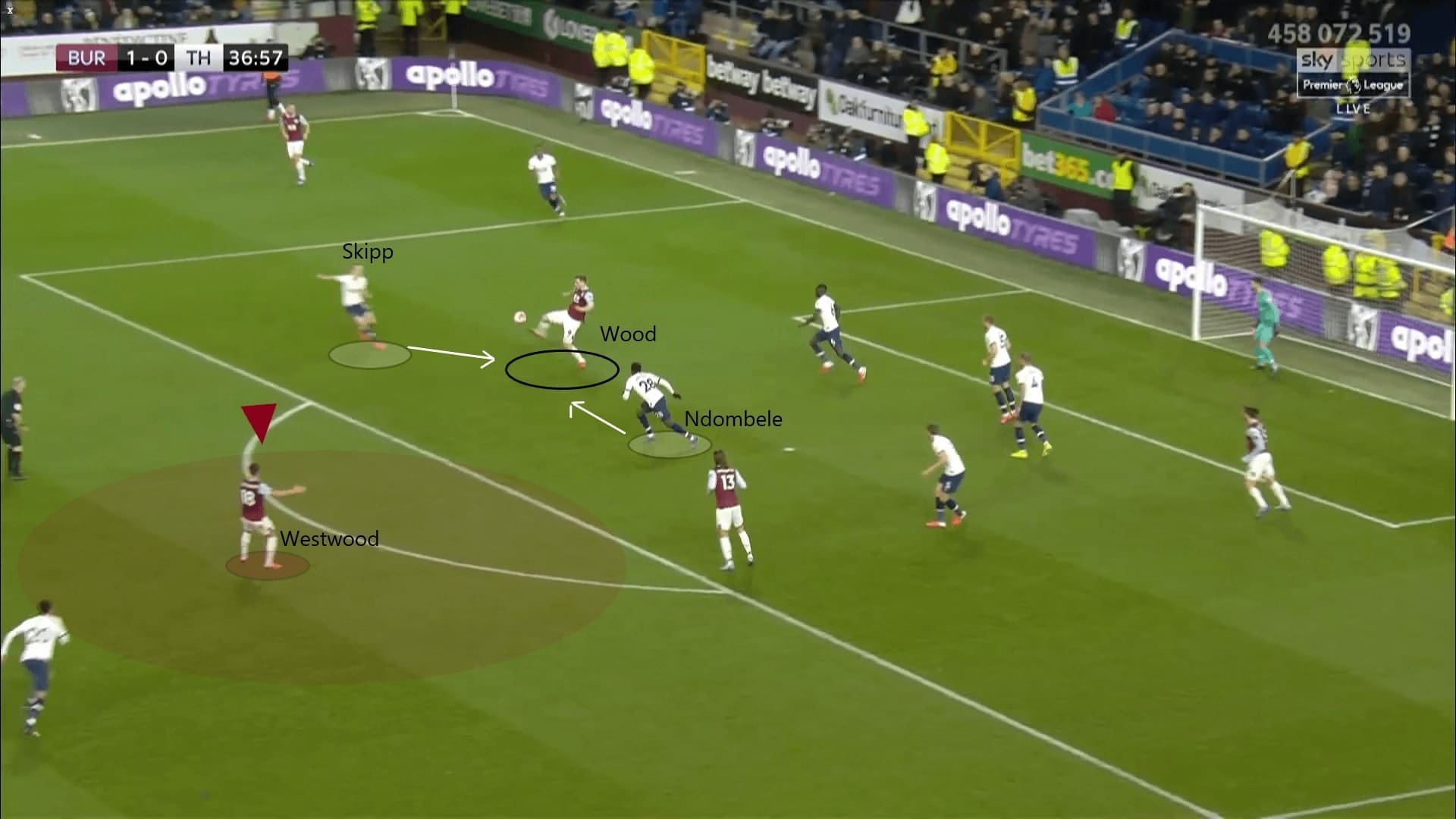
In this image, we tried to show something more than the structural issue. Again, Tottenham retreated their players to the penalty box to defend the cross. You can see Skipp and Ndombélé also stayed in their own box. However, everyone was looking at the ball and it seemed that they forgot zone 14 needed protection. In this case, Rodriguez could shoot easily without pressure.
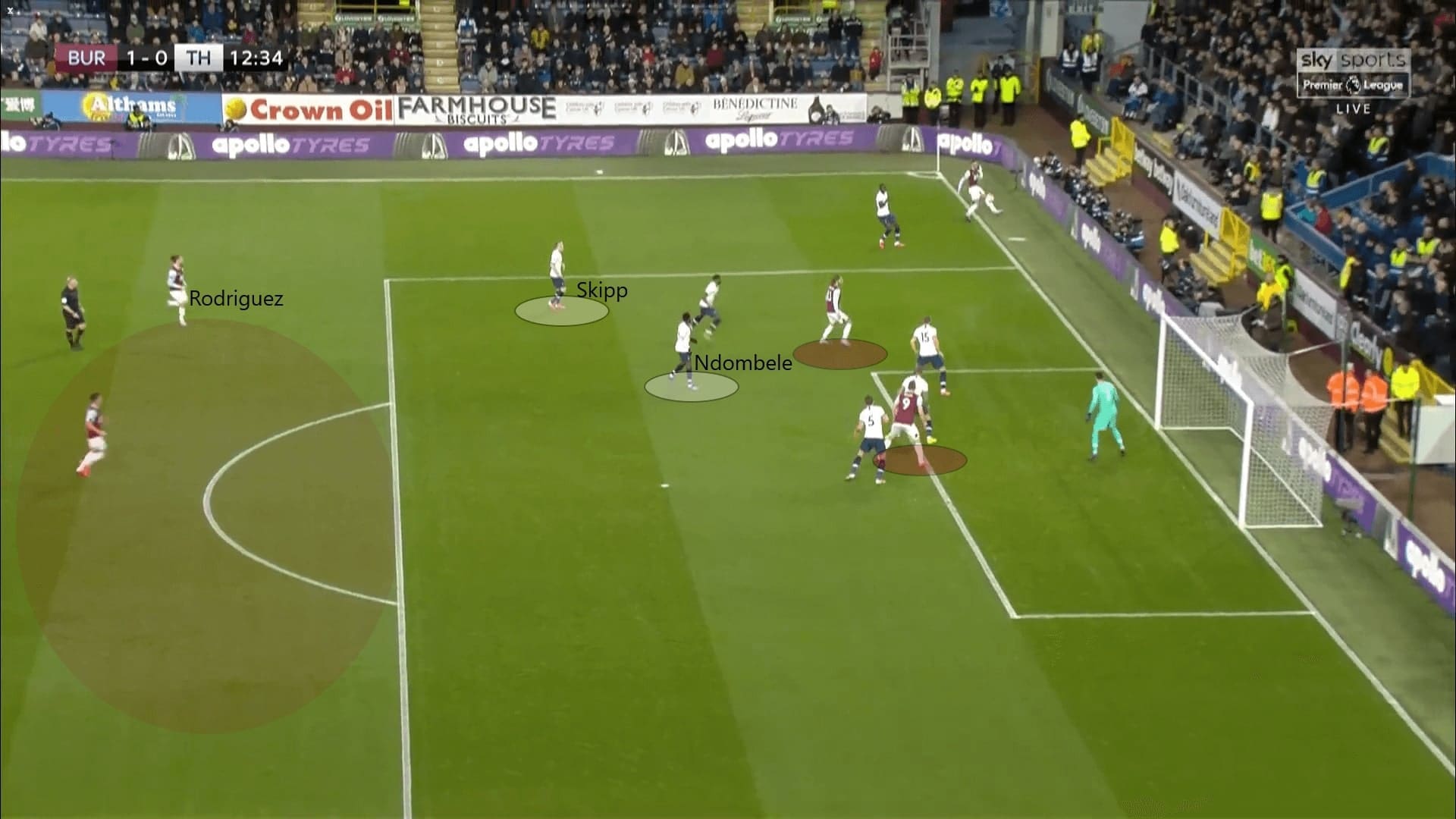
Lo Celso and Moura in
Given the poor display of the team in the first half, Mourinho quickly replaced Ndombélé and Skipp with Giovani Lo Celso and Moura, they also switched the formation to a 4-4-2. Both players made an impact in the second half. In this final section, we are going to explain their function and what they offered to the team.
In the build-up phases, Tottenham did not improve greatly as the issues remained unsettled. The pivots were not mobile enough to provide options and they lacked the patience to move the ball. The main advantage of the substitutions was reflected in the offensive transitions.
When comparing with Ndombélé and Skipp, their replacements had a better sense of attack. In this example, we saw Lo Celso was carrying the ball forward in the counter-attack and he drew two Burnley players to him. The most valuable part was the quality of his outball; despite being under pressure and carrying the ball, the Argentine was still able to pick out Bergwijn at the centre.
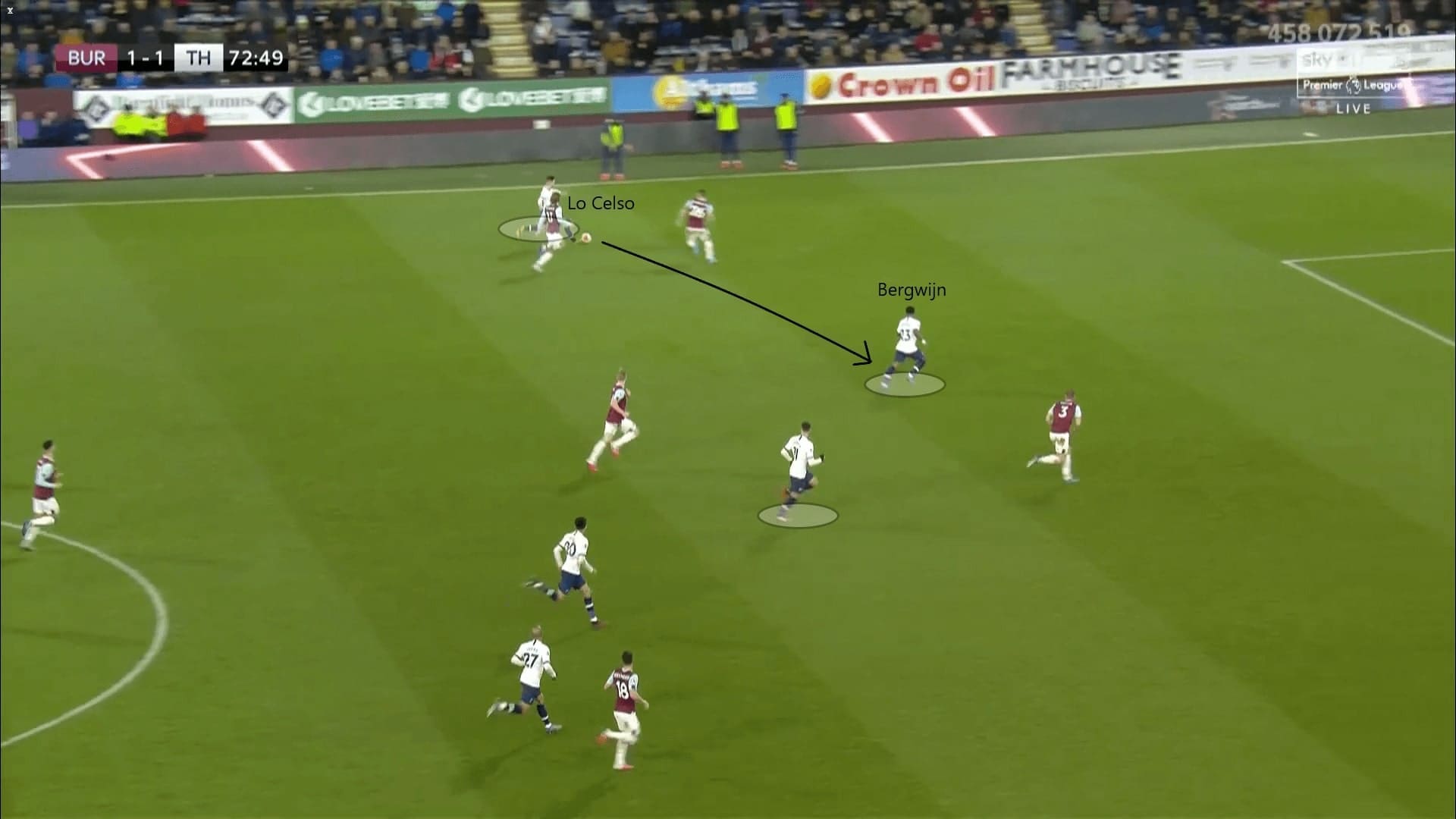
Another advantage was reflected numerically. In the first half, usually, only Alli, Lamela and Bergwijn were involved in the offensive transitions. In other words, when one was carrying the ball, he only had two forward options. However, the introduction of Moura injected pace into these counter-attacks.
Therefore, the ball carrier had three options in the transitions, which made Burnley more difficult to defend. In this example, we saw the Clarets defenders stay narrow to defend Bergwijn and Lamela, which left the space for Moura to exploit. The Brazilian had sufficient pace to exploit the uncovered area as arrowed in this image. Therefore, Alli could pick out the Brazilian and it was a good chance for Tottenham.
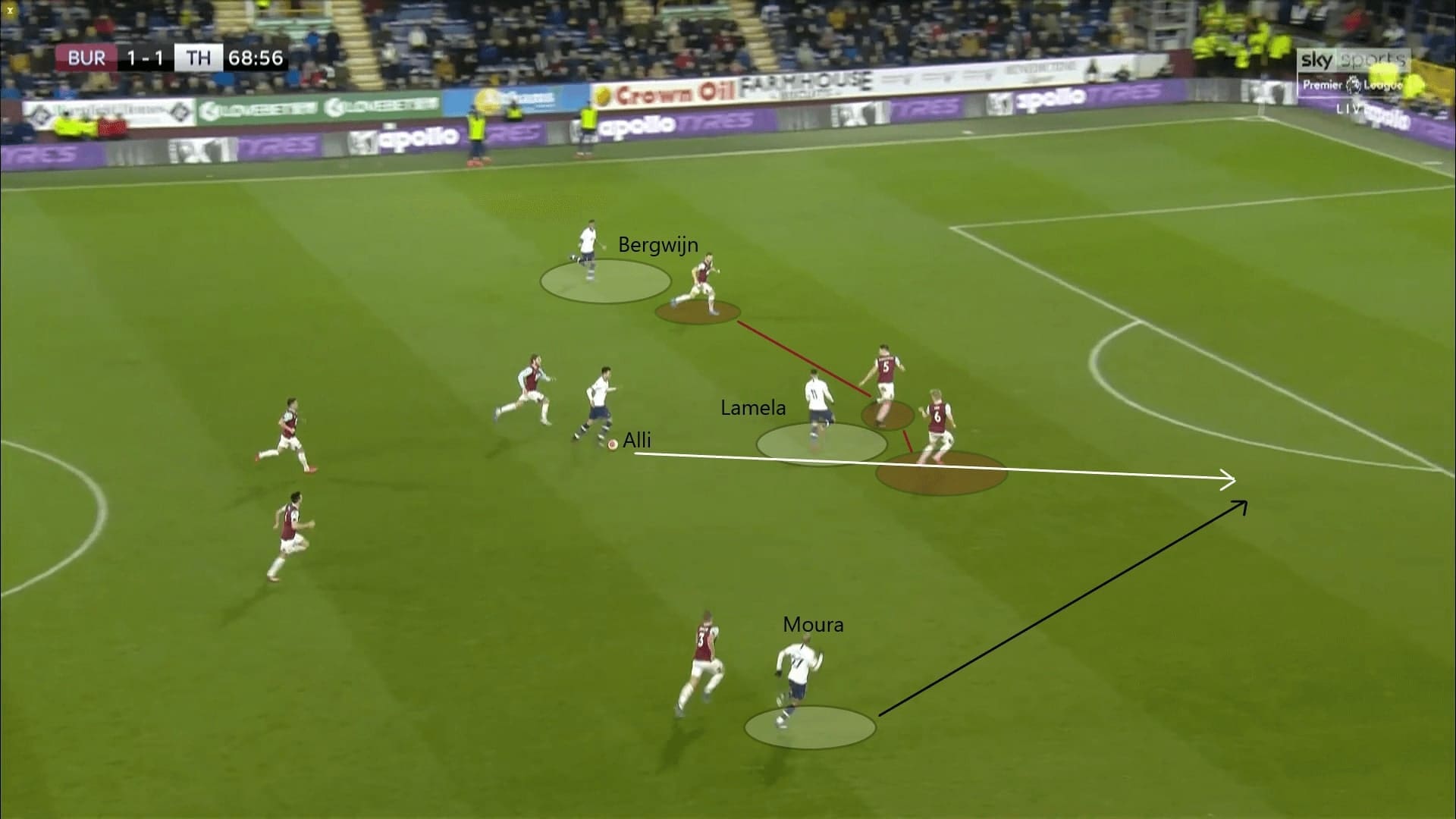
Conclusion
Burnley had a really good game and were slightly unfortunate to obtain one point only. Defensively, they were well-organized and disciplined. Tottenham had no method to break the press or the block of the Clarets. A bigger surprise was the offensive performance of the team as they troubled Tottenham’s defence and utilized the width of the pitch. It was very wise to maximize their strengths and exploit the oppositions’ weaknesses.
For Tottenham, it was a disappointing first half. In the second half, they were slightly better but their method of attack was still a question. Without Harry Kane and Heung-min Son, Mourinho lacked reliable central options in the attack. However, the issues which happened in this game were not something new; the build-up structure was too predictable and the awkward positioning of the wing-backs has been seen before. Mourinho has to solve these issues to further push Tottenham into a higher position in the league.





Comments